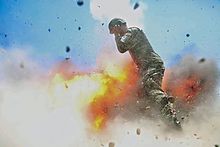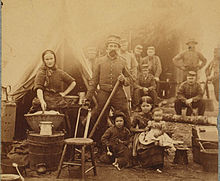War photography


War photography is the field of photojournalism that reports on wars and armed conflicts . The term is also used more broadly for any photographic and film documentation of war. Before the development of practical photographic equipment , the visual documentation of armed conflicts was taken over by war painters.
Term expansion
In a broader sense, photographs that are used for military reconnaissance and documentation, such as aerial photographs before and after bombings , can also be referred to as war photographs. Another special position is taken by photographs that are created and used by a party involved in the conflict for propaganda purposes. A new development, the effects of which cannot yet be estimated, is the increasingly easy distribution of private photos of soldiers or other conflict participants thanks to digital photography and the Internet . Such recordings played an important role , for example, in the torture scandal in Abu Ghuraib prison .
history
The Mexican-American War 1846–1848 is the first war in which photography was taken. The recordings are daguerreotypes . War photography essentially originated in the Crimean War and the American Civil War . Professional studio photographers visited the battlefields of their own accord after the fighting or were encouraged to do so by the government. For the first time, they offered the public a more realistic image than was possible with the otherwise common glorifying history painting.
The northern states put in the Civil War under the direction of renowned studio photographer Mathew Brady professional teams of 22 units, which were equipped with fully mobile development and enlargement of laboratories. It was also Brady who arranged for a number of photographs of amputation victims and invalids after the war , who were given a reasonably decent life with early forms of plastic surgery . As image documents for medical history , they are essential.
War photography experienced a radical expansion and reorientation when pictures were first printed in the illustrated mass press in the 1890s. The Spanish-American War of 1898 , the South African War of 1899–1902 (“ Boer War ”) and the Russo-Japanese War of 1904–1905 were already widely reflected in the illustrated (weekly) press.
Many of the recordings made during World War I , which had been considered authentic for decades, turned out to be photographs taken in retrospect or long after the fighting ended in recent years and when studying the sources. Even after the experience of the Spanish Civil War at the beginning of the Second World War, it was still customary to take posed recordings for security reasons.
The First World War brought important innovations in visual war reporting: for the first time photography was used systematically and extensively for propaganda. All major warring states established their own photo propaganda agencies. In Germany, the “Bild- und Filmamt” (BUFA) was founded at the beginning of 1917 and was responsible for film and photo propaganda. In Austria-Hungary, too, in the spring of 1917 a picture propaganda site was created, the so-called “photo site”. On the side of the Allies, too, militarily controlled photo and image propaganda sites were set up, which soon competed with private image suppliers. In April 1915, the “Section Photographique de l'Armée française” (SPA) and the “Section Cinématographique de l'Armée” (SCA) were founded in France. The first official British photo reporters were admitted to the front in 1916, the “Canadian War Record Office” was founded in early 1916, and immediately after the American entry into the war in 1917 the state “Committee of Public Information”. The allocation of current photo material to the press was thus increasingly centralized and militarily controlled.
The Spanish Civil War and v. a. the Second World War brought an enormous boost to the image of war photographers. Gradually it was no longer just anonymous press photographers, but photo reporters who vouched for the quality of the images with their names.
Freedom of expression and information
War photographers try to take pictures for news agencies - often at the risk of life and limb. Their independent work is particularly important for freedom of expression and information , as the warring parties are interested in information obfuscation and disinformation. Even democratic states are still trying to exercise censorship, be it with enormous technical effort or targeted influencing - compare the problem of " embedded journalists " in the Third Gulf War .
Eminent war photographers
- Eddie Adams , US photojournalist in the Vietnam War . Well-known photo of the execution of a Viet Cong by General Loang in Saigon , Vietnam
- Mathew B. Brady , US Civil War photographer
- Larry Burrows , English photographer during the Vietnam War for Life Magazine . Came in 1971 with three colleagues in a helicopter shooting down over Laos to
- Robert Capa , US photographer of Hungarian origin, chronicler of the invasion of Normandy
- Horst Faas , German Associated Press (AP) photographer in the Vietnam War, Algeria , Congo : Two Pulitzer Prizes , Robert Capa Gold , Erich Salomon Prize
- Roger Fenton , first commissioned photographer, Crimean War , 1855, modified calotype process
- Alexander Gardner , as before, started out as a Brady employee
- Philip Jones Griffiths , Wales , Vietnam War photojournalist
- Henri Huet , French AP photographer during the Vietnam War. Died in 1971 with three other photographers in a helicopter shooting down over Laos
- Don McCullin , English photographer who harrowing among other images from Vietnam and from the Lebanon war and the unrest in Cyprus made
- James Nachtwey , USA, perhaps the most famous war photographer at the moment. He reported from many crisis areas and has received many awards. In December 2003 he was seriously injured by a grenade during the Iraq war
- Timothy H. O'Sullivan , US Civil War photographer
- George Silk , tech-savvy photographer who visualized the horrors of war in New Guinea , on the Western Front during World War II and in Hiroshima
- Dana Stone , American photojournalist for United Press International (UPI). Killed in Cambodia in 1971 by soldiers of the Khmer Rouge near Bei Met, still missing today
- Nick Út , Vietnamese photographer, famous photo of the "napalm girl" Phan Thị Kim Phúc from Trảng Bàng , Vietnam
Eminent war photographers
- As Lieutenant Colonel, Margaret Bourke-White was the first female war correspondent for the US armed forces and produced harrowing photographic documents of the Buchenwald concentration camp
- Camille Lepage reported on the civil war in Central Africa
- Lee Miller provided photographic documents from the “ London Blitz ” and from the Allied invasion to the end of World War II and documented the liberation of the Buchenwald and Dachau concentration camps : her works are counted among the most important photographic works of the 20th century
- Alice Schalk wrote travel feuilletons and war reports on the First World War as a journalist ; she was the only war correspondent of the kuk "war press quarters"
- Christine Spengler
- Gerda Taro and her partner Robert Capa documented the atrocities of the Spanish Civil War
- Anja Niedringhaus was a German photojournalist who told complex stories from war zones in Yugoslavia , Palestine , Afghanistan , Kuwait , Libya and Iraq in individual photos.
literature
- Rainer Fabian, Hans Christian Adam: Images from the war. 130 years of war photography - an indictment. Gruner and Jahr, Hamburg 1983, ISBN 3-570-07013-1 .
- Robert Fox: Camera in Conflict. Könemann, Cologne 1996, ISBN 3-89508-217-1 .
- Neil MacDonald, Peter Brune: 200 shots. Damien Parer , George Silk and the Australians at was in New Guinea. Allen & Unwin, St. Leonards, NSW 1999, ISBN 1-86448-912-X .
- Photo history magazine : Special issue war and photography. Issue 85/85, 2002.
- Susan Sontag : Looking at the Suffering of Others. German by Reinhard Kaiser. Hanser, Munich / Vienna 2003, ISBN 3-446-20396-6 .
- Anton Holzer (Ed.): Armed with the camera. War and photography. Jonas Verlag, Marburg 2003, ISBN 3-89445-324-9 .
- Gerhard Paul : Images of War - War of Images. The visualization of modern war. Fink, Munich a. a. 2004, ISBN 3-506-71739-1 .
- Ute Daniel (Ed.): Eyewitnesses. War reporting from the 18th to the 21st century. Vandenhoeck & Ruprecht, Göttingen 2006, ISBN 3-525-36737-6 .
- Anton Holzer: The other front. Photography and propaganda in the First World War. Primus, Darmstadt, 3rd edition 2012, ISBN 978-3-86312-032-0 .
- Anton Holzer: The last days of mankind. The First World War in pictures. Primus, Darmstadt, 2013, ISBN 978-3-86312-004-7 .
- Michael Kirchdorfer: "True Captions": A study on the interpretative use of captions in the context of postmodern war photography. Master's thesis, University of Vienna, 2010. (abstract and full text)
- The world war of images. Photo reportage and war propaganda in the illustrated press 1914–1918. Special issue of the magazine Fotogeschichte, issue 130, 2013.
- War photographers. Special issue of the magazine Fotogeschichte, ed. by Marion Beckers and Elisabeth Moortgat, issue 134, 2014.
Films about war photography
- Martin Luksan : Photos from the front. German war photography in World War II . (First broadcast: September 7, 2009) ISBN 978-3-86569-094-4 .
- Christian Frei: War Photographer (documentary about James Nachtwey). 2003
- The German war photographer Ursula Meissner in conversation: http://www.hopechannel.de/mediathek/beitrag/ml/auserlesen/titus-mueller-im-gespraech-mit-ursula-meissner//48/
Web links
- Solveig Grothe: Early War Photography - Looking the dead in the eye. on one day .
Individual evidence
- ↑ Badische-zeitung.de , Computer & Medien , February 20, 2016, Bettina Schulte: "Struck out of history" (February 20, 2016)



